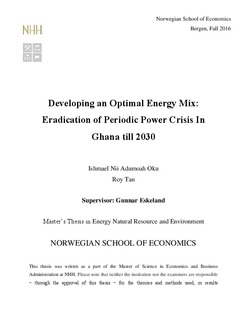Developing an optimal energy mix : eradication of periodic power crisis in Ghana till 2030
Master thesis
Permanent lenke
http://hdl.handle.net/11250/2432657Utgivelsesdato
2016Metadata
Vis full innførselSamlinger
- Master Thesis [4372]
Sammendrag
The present situation in Ghana presents major challenges in providing the required energy in a
reliable and sustainable manner considering environmental and economic impacts of energy
production and use and the nexus between energy and development. Despite having no lack of
endowment with varied natural resources, some with significant potential, Ghana has had several
energy crises in the past four decades and is currently in the midst of one.
The Strategic National Energy Planning Authority formulated a comprehensive plan for the
development, utilization and efficient management of energy resources available to the country
and has defined a target basket of energy mix to flexibly avail production to keep up with the
country’s general trend of an expanding economy, growing population and the country’s energy
question.
This paper presents some historical energy use patterns in Ghana, an overview of the relevant
governmental bodies and policies that were put in place to define the future energy scenery with
the main objective of proposing an ‘optimal’ course of action towards practical execution of
energy project mix in line with the national’s strategic targets and plans capable of supplying the
annual electrical energy needs of Ghana in order to eradicate periodic power crisis in Ghana
from 2016 till 2030 (given Ghana’s current endowments). Using a linear optimization model,
this thesis also seeks to provide an optimal energy mix with an optimal year-on-year energy
resource development path that will ensure growing annual energy demand is met with the least
economic impact. The paper does this by considering generation from various energy sources,
such as gas, nuclear, hydro, wind and solar photovoltaic in keeping up with the strategic
renewable mix (excluding large hydro and nuclear) of 10% of installed capacity from 2020
onwards.
